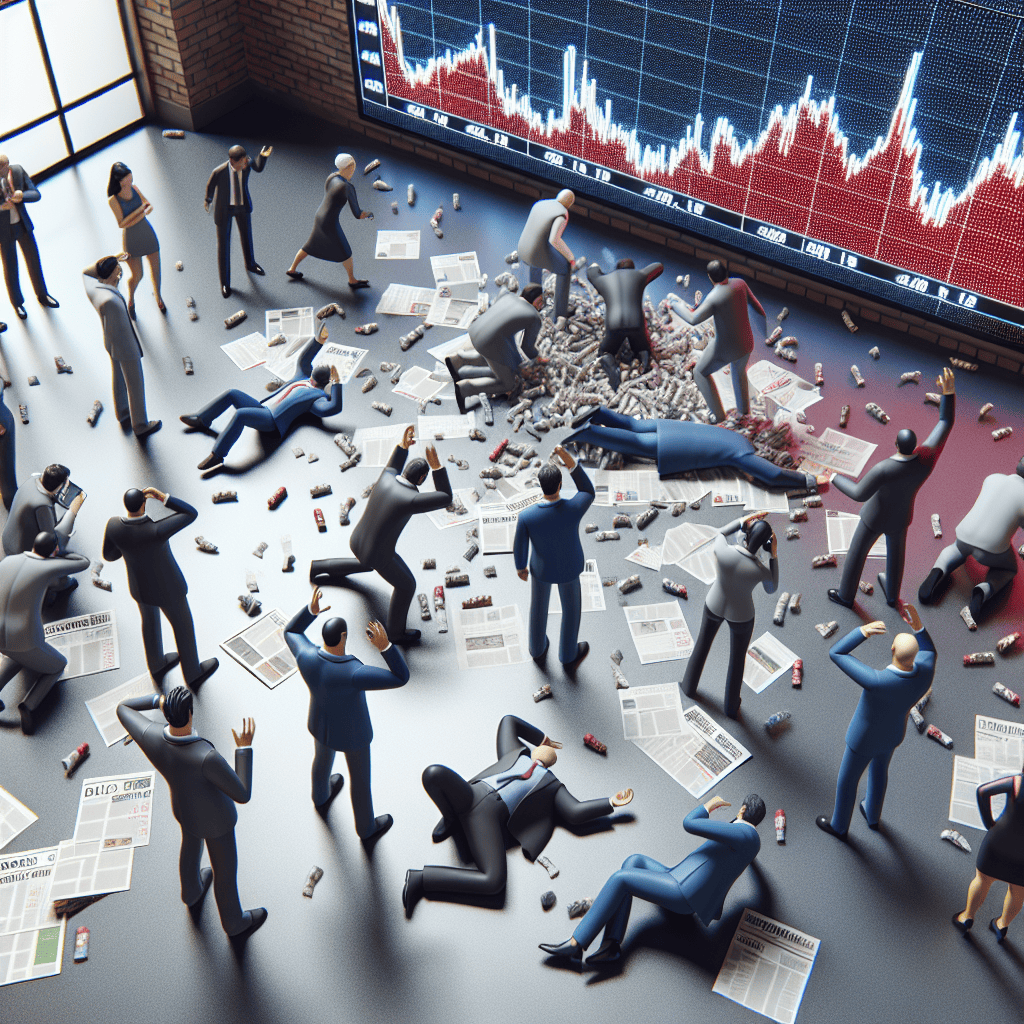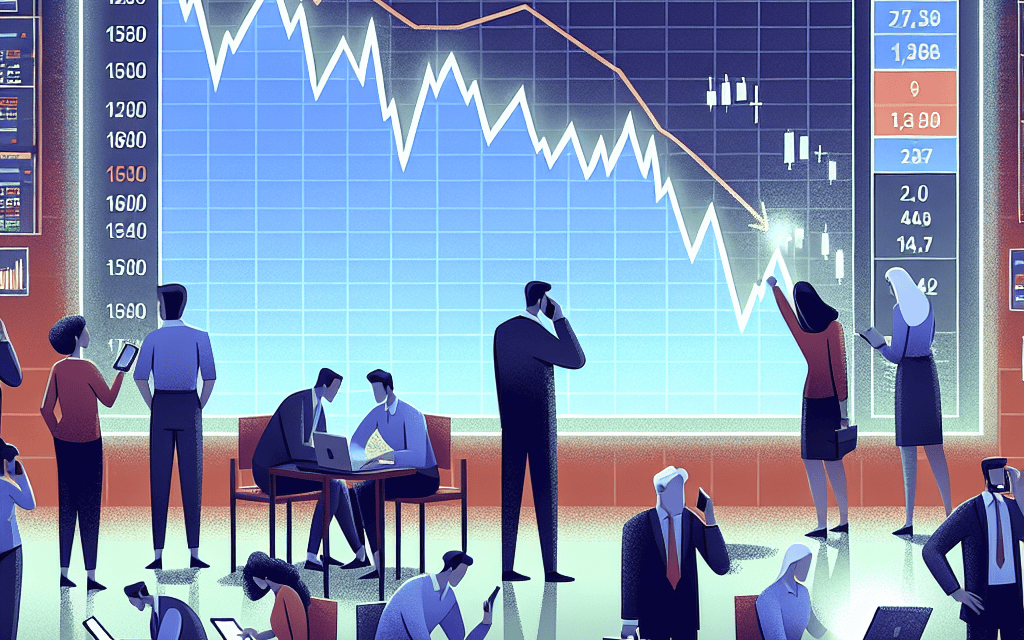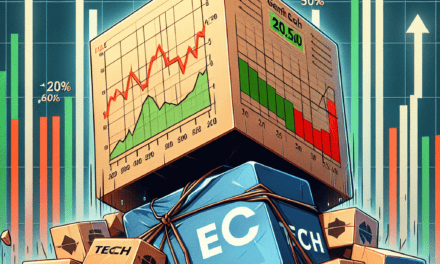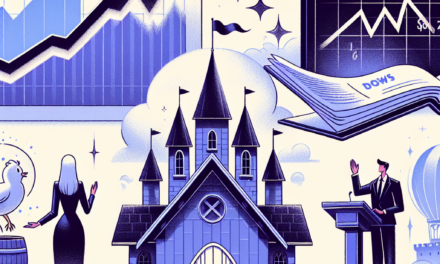“Market Jitters: Dow Dips 150 Points Ahead of Election Day Uncertainty”
Introduction
On the eve of a pivotal Election Day, the stock market exhibited signs of apprehension as the Dow Jones Industrial Average fell by 150 points. This decline reflects the uncertainty and cautious sentiment among investors as they brace for the potential economic and political ramifications of the election outcomes. Market participants are closely monitoring the electoral landscape, aware that the results could significantly influence fiscal policies, regulatory environments, and overall market stability. The drop in the Dow underscores the heightened volatility and sensitivity of financial markets during periods of political transition, as investors seek to navigate the complexities and anticipate the future direction of the economy.
Impact Of Election Day On Stock Market Volatility
As Election Day approaches, the stock market often experiences heightened volatility, a phenomenon that has been observed consistently over the years. This year is no exception, as evidenced by the Dow Jones Industrial Average’s recent decline of 150 points. Investors are keenly aware that political events can significantly influence market dynamics, and the anticipation of potential policy shifts or economic reforms can lead to increased market fluctuations. Consequently, the period leading up to an election is often marked by uncertainty, prompting investors to reassess their portfolios and strategies.
The relationship between elections and market volatility is complex, driven by a multitude of factors. Primarily, the uncertainty surrounding election outcomes can lead to market instability. Investors are typically concerned about how the results might impact fiscal policies, regulatory changes, and international relations, all of which can have profound effects on corporate earnings and economic growth. For instance, a change in administration might bring about new tax policies or trade agreements, which could either bolster or hinder certain sectors. As a result, investors often adopt a cautious approach, leading to fluctuations in stock prices as they adjust their positions in anticipation of these potential changes.
Moreover, historical data suggests that markets tend to react differently depending on whether the incumbent party retains power or a new party takes control. Generally, markets prefer predictability and stability, which is often associated with the continuation of existing policies. However, when a new party is expected to take office, the uncertainty regarding future policy directions can exacerbate market volatility. This is particularly true if the incoming administration is perceived to have significantly different economic priorities or if there is a lack of clarity about their proposed policies.
In addition to domestic factors, global economic conditions also play a crucial role in influencing market behavior during election periods. For instance, geopolitical tensions, trade negotiations, and international economic trends can all contribute to market volatility. Investors must consider how these external factors might interact with domestic political changes, further complicating their decision-making processes. This interconnectedness underscores the importance of a comprehensive approach to market analysis, particularly during times of political transition.
Furthermore, it is important to note that while short-term volatility is common around elections, the long-term impact on the stock market is often less pronounced. Historical trends indicate that markets tend to stabilize after the initial uncertainty subsides and investors gain clarity on the new administration’s policies. In many cases, the market’s long-term trajectory is more closely aligned with underlying economic fundamentals rather than political events. Therefore, while the immediate reaction to an election can be volatile, it is essential for investors to maintain a focus on broader economic indicators and trends.
In conclusion, the decline of 150 points in the Dow Jones Industrial Average serves as a reminder of the inherent volatility associated with election periods. As investors navigate this uncertain landscape, they must carefully weigh the potential implications of political changes against the backdrop of global economic conditions. By adopting a strategic and informed approach, investors can better manage the risks associated with election-related market volatility and position themselves for long-term success. As Election Day draws nearer, the focus will remain on how the anticipated outcomes might shape the economic and financial landscape in the months and years to come.
Historical Trends: How Elections Influence The Dow
As Election Day approaches, the financial markets are once again under the microscope, with investors keenly observing the potential impact of political outcomes on their portfolios. Historically, the Dow Jones Industrial Average, a key barometer of the U.S. stock market, has exhibited varied responses to election cycles, reflecting the complex interplay between politics and market sentiment. Understanding these historical trends can provide valuable insights into how the Dow might react in the current political climate.
Traditionally, the stock market tends to experience heightened volatility in the months leading up to a presidential election. This is largely due to the uncertainty surrounding potential policy changes that could arise from a shift in political power. Investors often grapple with the implications of differing economic agendas, which can influence sectors ranging from healthcare to energy. Consequently, the Dow may experience fluctuations as market participants adjust their expectations based on the perceived likelihood of each candidate’s victory.
Looking back at past election cycles, it becomes evident that the Dow’s performance is not solely dictated by the election outcome itself but also by the broader economic context. For instance, during the 2008 financial crisis, the Dow experienced significant declines regardless of the election results, as the market was primarily driven by economic instability. Conversely, in more stable economic periods, the market’s reaction to elections has been more directly tied to the anticipated policies of the incoming administration.
Moreover, historical data suggests that the Dow often experiences a post-election rally, commonly referred to as a “relief rally,” once the uncertainty of the election is resolved. This phenomenon occurs as investors gain clarity on the future policy direction and adjust their strategies accordingly. However, the magnitude and duration of such rallies can vary significantly depending on the prevailing economic conditions and the market’s initial expectations.
In addition to presidential elections, midterm elections also play a crucial role in shaping market dynamics. Historically, the Dow has shown a tendency to perform well in the year following midterm elections, a pattern attributed to the reduction of political uncertainty and the market’s anticipation of favorable policy outcomes. This trend underscores the importance of political stability in fostering investor confidence and driving market performance.
While historical trends provide a useful framework for understanding potential market reactions, it is essential to recognize that each election cycle is unique, influenced by a myriad of factors including geopolitical tensions, economic indicators, and technological advancements. As such, investors must remain vigilant and adaptable, continuously reassessing their strategies in response to evolving circumstances.
In conclusion, as the Dow falls 150 points in anticipation of Election Day, it serves as a reminder of the intricate relationship between politics and the stock market. By examining historical trends, investors can gain a deeper understanding of how elections have influenced the Dow in the past, while also acknowledging the inherent uncertainties that accompany each new election cycle. As the nation prepares to cast its votes, the financial markets will undoubtedly continue to reflect the complex interplay of political and economic forces, shaping the investment landscape for years to come.
Investor Strategies During Political Uncertainty
As the Dow Jones Industrial Average experiences a decline of 150 points, investors are increasingly focused on strategies to navigate the uncertainties associated with the upcoming election. Political events have historically influenced market behavior, and this election cycle is no exception. The fluctuations in the stock market reflect the broader economic anxieties that often accompany political transitions. Investors are keenly aware that the outcome of the election could have significant implications for fiscal policy, regulatory changes, and international trade agreements, all of which can impact market performance.
In times of political uncertainty, investors often seek to mitigate risk by diversifying their portfolios. Diversification is a fundamental strategy that involves spreading investments across various asset classes to reduce exposure to any single risk. By holding a mix of stocks, bonds, and other securities, investors can better withstand market volatility. This approach is particularly relevant during election periods when market sentiment can shift rapidly based on political developments. Moreover, diversification can provide a buffer against potential policy changes that may favor certain sectors over others.
Another strategy that investors might consider is focusing on companies with strong fundamentals. Firms with solid balance sheets, consistent earnings growth, and competitive advantages are generally better positioned to weather economic and political uncertainties. These companies tend to have the resilience needed to adapt to changing regulatory environments and economic conditions. By prioritizing investments in such firms, investors can enhance their portfolios’ stability during turbulent times.
Additionally, some investors turn to safe-haven assets as a means of protection against market volatility. Gold, for instance, is often viewed as a store of value during periods of uncertainty. Its historical role as a hedge against inflation and currency fluctuations makes it an attractive option for those looking to preserve capital. Similarly, U.S. Treasury bonds are considered low-risk investments that can provide a steady income stream, even when equity markets are unpredictable. Allocating a portion of a portfolio to these assets can help investors manage risk while maintaining potential for returns.
Furthermore, investors may also consider the potential impact of fiscal and monetary policies that could be enacted post-election. Depending on the election outcome, there could be shifts in government spending, tax policies, and interest rates, all of which can influence market dynamics. Staying informed about policy proposals and their potential economic implications can help investors make more informed decisions. Engaging with financial advisors and conducting thorough research are prudent steps in aligning investment strategies with anticipated policy changes.
In conclusion, as the Dow Jones Industrial Average reflects the market’s apprehension ahead of Election Day, investors are employing various strategies to navigate the political uncertainty. Diversification, focusing on companies with strong fundamentals, and considering safe-haven assets are among the approaches being utilized to manage risk. Additionally, staying informed about potential policy changes and their economic impacts is crucial for making strategic investment decisions. By adopting these strategies, investors can better position themselves to weather the uncertainties of the election cycle and beyond, ensuring that their portfolios remain resilient in the face of potential market fluctuations.
Analyzing The Dow’s Reaction To Political Events

As the financial world closely monitors the ebb and flow of the stock market, the Dow Jones Industrial Average recently experienced a notable decline, shedding 150 points. This downturn comes as investors brace themselves for the uncertainties surrounding Election Day. Historically, the stock market has often reacted to political events with varying degrees of volatility, and this instance is no exception. The anticipation of potential policy shifts and economic strategies that could emerge from the election results has left investors in a state of cautious apprehension.
To understand the Dow’s reaction, it is essential to consider the broader context of how political events influence market behavior. Elections, by their very nature, introduce a level of unpredictability that can unsettle investors. The prospect of a change in administration or shifts in congressional power can lead to speculation about future economic policies, including taxation, regulation, and government spending. These factors, in turn, have a direct impact on corporate profitability and economic growth, which are critical determinants of stock market performance.
Moreover, the lead-up to an election often sees heightened rhetoric and policy proposals from candidates, which can further contribute to market fluctuations. Investors, seeking to mitigate risk, may adjust their portfolios in anticipation of these potential changes. This reallocation of assets can result in increased market volatility, as seen in the recent decline of the Dow. Additionally, the uncertainty surrounding the election outcome can lead to a temporary pause in investment decisions, as market participants adopt a wait-and-see approach.
It is also important to recognize that the stock market is not solely driven by domestic political events. Global economic conditions, geopolitical tensions, and other external factors play a significant role in shaping investor sentiment. However, during election periods, the focus often shifts more acutely to domestic issues, amplifying the impact of political developments on market dynamics. This heightened sensitivity can lead to exaggerated market movements, as investors react to both real and perceived threats to economic stability.
In the current scenario, the decline in the Dow may also reflect broader concerns about the economic outlook. With ongoing challenges such as inflationary pressures, supply chain disruptions, and the lingering effects of the pandemic, investors are already navigating a complex landscape. The added layer of election-related uncertainty compounds these challenges, prompting a more cautious stance among market participants.
As Election Day approaches, it is crucial for investors to maintain a long-term perspective. While short-term volatility is often an inevitable consequence of political events, historical trends suggest that markets tend to stabilize over time. The key for investors is to remain informed and adaptable, recognizing that while elections can introduce temporary disruptions, they also present opportunities for strategic positioning.
In conclusion, the recent 150-point drop in the Dow underscores the intricate relationship between political events and market behavior. As investors prepare for Election Day, the interplay of uncertainty, policy speculation, and broader economic conditions will continue to shape market dynamics. By understanding these factors and maintaining a balanced approach, investors can navigate the complexities of the market with greater confidence, even amidst the uncertainties of the political landscape.
The Role Of Economic Policies In Market Fluctuations
As Election Day approaches, the financial markets are experiencing heightened volatility, with the Dow Jones Industrial Average recently falling by 150 points. This decline underscores the intricate relationship between economic policies and market fluctuations, a dynamic that becomes particularly pronounced during election cycles. Investors are keenly aware that the outcome of an election can significantly influence economic policies, which in turn can have profound effects on market performance. Consequently, the anticipation of potential policy shifts often leads to increased market activity and volatility.
Economic policies, encompassing fiscal and monetary measures, play a pivotal role in shaping the economic landscape. Fiscal policies, which include government spending and taxation, directly impact economic growth and consumer spending. For instance, a government that prioritizes increased public spending may stimulate economic growth, thereby boosting investor confidence and potentially driving up stock prices. Conversely, policies that focus on reducing government expenditure or increasing taxes might lead to slower economic growth, prompting investors to adopt a more cautious approach.
Monetary policies, primarily managed by central banks, also significantly influence market dynamics. Interest rates, a key tool of monetary policy, affect borrowing costs for consumers and businesses. Lower interest rates typically encourage borrowing and investment, leading to economic expansion and potentially higher stock prices. On the other hand, higher interest rates can dampen economic activity by increasing borrowing costs, which may result in lower stock valuations. As investors anticipate changes in monetary policy, particularly in response to election outcomes, market volatility can increase as they adjust their portfolios accordingly.
The interplay between economic policies and market fluctuations is further complicated by the global nature of modern financial markets. International trade policies, for example, can have far-reaching effects on domestic markets. A government that adopts protectionist trade measures may initially boost certain domestic industries, but such policies can also lead to retaliatory actions from trading partners, ultimately affecting global supply chains and market stability. Investors must therefore consider not only domestic economic policies but also their potential international repercussions.
As Election Day nears, investors are closely monitoring the policy platforms of candidates and political parties. The potential for significant policy shifts, such as changes in tax regulations, healthcare reforms, or environmental policies, can lead to uncertainty in the markets. This uncertainty often results in increased market volatility as investors attempt to predict and position themselves for the possible outcomes. Moreover, the historical context of previous elections and their impact on economic policies provides valuable insights for investors seeking to navigate the current market environment.
In addition to the direct impact of economic policies, investor sentiment plays a crucial role in market fluctuations. The perception of political stability or instability can influence investor confidence, further contributing to market volatility. During election periods, the heightened focus on political developments can amplify these sentiments, leading to more pronounced market movements.
In conclusion, the recent decline in the Dow Jones Industrial Average highlights the significant role that economic policies play in market fluctuations, particularly during election cycles. As investors prepare for Election Day, they must carefully consider the potential implications of policy changes on both domestic and global markets. By understanding the complex interplay between economic policies and market dynamics, investors can better navigate the uncertainties and opportunities that arise during this critical period.
Comparing Pre-Election Market Movements Over The Years
As Election Day approaches, the financial markets often exhibit heightened volatility, reflecting the uncertainty and anticipation that accompany such pivotal events. This year, the Dow Jones Industrial Average has experienced a decline of 150 points, a movement that underscores the cautious sentiment among investors. Historically, pre-election market movements have varied significantly, influenced by a myriad of factors including economic conditions, geopolitical tensions, and the perceived impact of potential policy changes. By examining these historical trends, we can gain a deeper understanding of the current market dynamics and the factors that may be influencing investor behavior.
Looking back at previous election cycles, it becomes evident that the stock market’s performance in the months leading up to an election can serve as a barometer of investor sentiment. For instance, during the 2008 financial crisis, the market was already under significant stress, and the uncertainty surrounding the election only added to the volatility. In contrast, the 2016 election saw a more mixed market response, with investors initially reacting negatively to the unexpected outcome before quickly rebounding as they reassessed the potential economic implications.
One of the key factors that often drives pre-election market movements is the anticipation of policy changes. Investors closely scrutinize the platforms of the major political parties, assessing how proposed policies might impact various sectors of the economy. For example, sectors such as healthcare, energy, and finance are particularly sensitive to regulatory changes, and any perceived shifts in policy direction can lead to significant market adjustments. This year, as investors brace for Election Day, similar considerations are at play, with market participants weighing the potential implications of the election outcome on fiscal policy, trade relations, and regulatory frameworks.
Moreover, the broader economic context in which an election takes place can also influence market behavior. In years where the economy is performing well, markets may exhibit more resilience to election-related uncertainty. Conversely, in times of economic distress, such as during a recession or a global crisis, the added uncertainty of an election can exacerbate market volatility. This interplay between economic conditions and election dynamics is a critical factor in understanding pre-election market movements.
In addition to domestic factors, global events can also play a significant role in shaping market sentiment ahead of an election. Geopolitical tensions, trade disputes, and international economic developments can all contribute to market uncertainty, compounding the effects of election-related anxieties. As investors navigate this complex landscape, they often seek refuge in safe-haven assets such as gold or government bonds, leading to fluctuations in equity markets.
While the Dow’s recent decline of 150 points may seem modest in the grand scheme of market movements, it serves as a reminder of the intricate web of factors that influence investor sentiment during election periods. By comparing pre-election market movements over the years, we can appreciate the diverse array of influences that shape market behavior and better understand the current environment. As Election Day draws nearer, investors will continue to monitor developments closely, adjusting their strategies in response to the evolving political and economic landscape. Ultimately, while history provides valuable insights, each election cycle presents its own unique set of challenges and opportunities, making the task of predicting market movements both complex and fascinating.
Expert Predictions: Post-Election Market Recovery Scenarios
As the Dow Jones Industrial Average experiences a decline of 150 points, investors are keenly focused on the upcoming election and its potential impact on the financial markets. Historically, elections have been pivotal events that can lead to significant market volatility, and this year is no exception. The uncertainty surrounding the election results, coupled with the economic challenges posed by the ongoing global pandemic, has created a complex environment for investors. Consequently, experts are diligently analyzing various post-election market recovery scenarios to provide guidance and insight into what the future may hold.
One of the primary factors influencing market behavior in the aftermath of an election is the anticipated policy direction of the incoming administration. Investors are particularly interested in understanding how new policies might affect key sectors such as healthcare, technology, and energy. For instance, a government that prioritizes renewable energy initiatives could lead to a surge in green technology stocks, while a focus on deregulation might benefit traditional energy sectors. Therefore, the market’s response is often closely tied to the perceived economic agenda of the elected officials.
Moreover, the composition of Congress plays a crucial role in shaping market expectations. A divided government, where one party controls the presidency and the other holds a majority in one or both houses of Congress, can lead to legislative gridlock. This scenario often results in a more cautious market outlook, as investors anticipate challenges in passing significant fiscal policies. Conversely, a unified government may lead to more decisive policy implementation, potentially boosting investor confidence and market performance.
In addition to domestic policy considerations, global economic factors are also at play. The interconnectedness of the global economy means that international trade agreements, geopolitical tensions, and foreign policy decisions can have far-reaching implications for market stability. Investors are particularly attentive to how the new administration will navigate relationships with major economic partners, as these interactions can influence trade flows and, consequently, market dynamics.
Furthermore, the Federal Reserve’s monetary policy remains a critical component of the post-election market landscape. The central bank’s approach to interest rates and quantitative easing measures can significantly impact investor sentiment and market liquidity. A commitment to maintaining low interest rates, for example, could encourage borrowing and investment, thereby supporting economic recovery. Conversely, any indication of tightening monetary policy might lead to increased market volatility as investors adjust their portfolios in response to changing financial conditions.
As investors brace for the election’s outcome, it is essential to recognize that market reactions can be swift and unpredictable. While some sectors may experience immediate gains or losses, others might see more gradual adjustments as the long-term implications of new policies become clearer. Therefore, experts advise maintaining a diversified investment strategy to mitigate risks associated with short-term market fluctuations.
In conclusion, while the Dow’s recent decline reflects current investor apprehension, the post-election period presents both challenges and opportunities for market recovery. By carefully analyzing potential policy shifts, congressional dynamics, global economic factors, and monetary policy, investors can better navigate the complexities of the post-election market environment. As always, staying informed and adaptable will be key to successfully managing investments in the face of uncertainty.
Q&A
1. **What caused the Dow to fall 150 points?**
Concerns over the upcoming election and potential market volatility led to the Dow’s decline.
2. **How are investors preparing for Election Day?**
Investors are adjusting their portfolios, seeking safe-haven assets, and closely monitoring political developments.
3. **What sectors were most affected by the Dow’s decline?**
Financials, technology, and industrials were among the sectors most impacted by the market downturn.
4. **What are safe-haven assets investors might consider?**
Gold, U.S. Treasury bonds, and the Japanese yen are common safe-haven assets during times of uncertainty.
5. **How might the election outcome impact the stock market?**
The election outcome could lead to policy changes affecting taxes, regulation, and government spending, influencing market performance.
6. **What are analysts predicting for the market post-election?**
Analysts predict increased volatility and potential market rallies or declines depending on the election results and subsequent policy directions.
7. **How did other major indices perform alongside the Dow?**
The S&P 500 and Nasdaq also experienced declines, reflecting broader market apprehension ahead of the election.
Conclusion
The Dow Jones Industrial Average fell by 150 points as investors exhibited caution ahead of Election Day. This decline reflects market uncertainty and apprehension about potential political and economic outcomes that could arise from the election results. Investors are likely adjusting their portfolios in anticipation of possible policy changes and their impact on various sectors. The market’s reaction underscores the influence of political events on financial markets and the importance of investor sentiment in driving short-term market movements.





